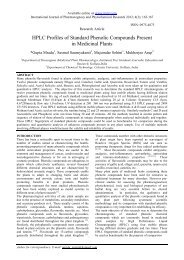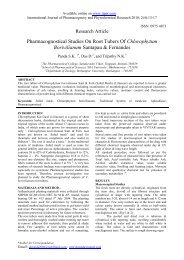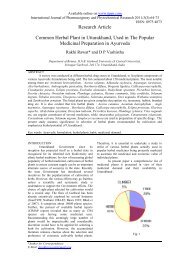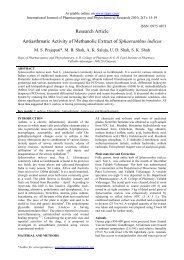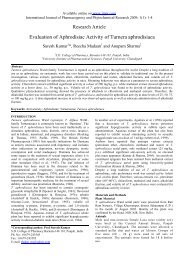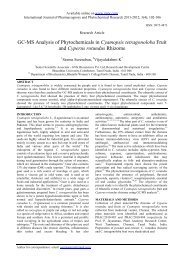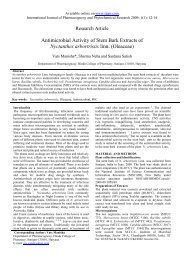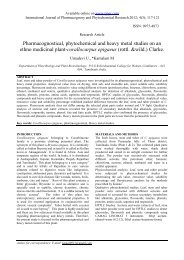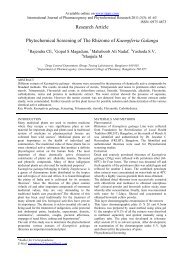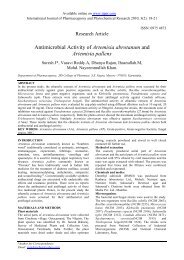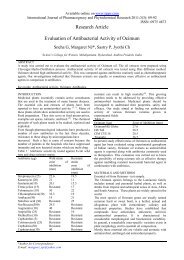Pharmacognostical standardization of elaeocarpus ganitrus leaf ...
Pharmacognostical standardization of elaeocarpus ganitrus leaf ...
Pharmacognostical standardization of elaeocarpus ganitrus leaf ...
You also want an ePaper? Increase the reach of your titles
YUMPU automatically turns print PDFs into web optimized ePapers that Google loves.
Available online on www.ijppr.com<br />
International Journal <strong>of</strong> Pharmacognosy and Phytochemical Research 2012; 4(3); 97-98<br />
Research Article<br />
ISSN: 0975-4873<br />
<strong>Pharmacognostical</strong> <strong>standardization</strong> <strong>of</strong> <strong>elaeocarpus</strong> <strong>ganitrus</strong> <strong>leaf</strong>.<br />
Family: elaeocarpaceae.<br />
Sameja Krunal 1 , *Rao Priya Shaival 1 , Rao Shaival K 1 , Jivani N P 1<br />
1 C.U Shah College <strong>of</strong> Pharmacy & Research, Wadhwan, Gujarat-363030<br />
ABSTRACT<br />
The present study was carried out in an attempt to study the pharmacognostical characteristics <strong>of</strong> the leaves <strong>of</strong><br />
Elaeocarpus <strong>ganitrus</strong>, Family: Elaeocarpaceae, commonly called as “Rudraksh”. Rudraksh beads have been used since<br />
ancient times as an adornment to ward <strong>of</strong>f evil spirits and omens.<br />
Keywords: Standardization, Rudraksh, Elaeocarpus, Elaeocarpaceae.<br />
INTRODUCTION<br />
Plant Description: Elaeocarpus <strong>ganitrus</strong> Roxb.<br />
(Synonym: Elaeocarpus sphaericus), Family:<br />
Elaeocarpaceae, is commonly known as Rudraksh. It is a<br />
medium sized tree occasionally cultivated for ornamental<br />
purpose 1 . The plant contains phytosterols, alkaloids, fat,<br />
carbohydrates, proteins and tannins 2 . The seeds <strong>of</strong> the<br />
plant have been reported to have good anticonvulsant<br />
activity 3 .<br />
MATERIALS AND METHODS<br />
Plant material: The <strong>leaf</strong> <strong>of</strong> Elaeocarpus <strong>ganitrus</strong> was<br />
collected from the medicinal garden <strong>of</strong> C.U Shah College<br />
<strong>of</strong> Pharmacy & Research, Wadhwan, Gujarat in the<br />
month <strong>of</strong> February, 2011. It was identified by Late Pr<strong>of</strong>.<br />
Taxonomy<br />
Division Magnoliophyta<br />
Class<br />
Magnoliatae<br />
Order<br />
Malvales<br />
Family Elaeocarpaceae Juss. ex DC.<br />
Genus Elaeocarpus L.<br />
Species Elaeocarpus <strong>ganitrus</strong> Roxb.<br />
Dr. M A Iyengar. Voucher specimen was deposited in<br />
Department <strong>of</strong> Pharmacognosy, C. U Shah College <strong>of</strong><br />
Pharmacy & Research, Wadhwan, Gujarat. Fresh <strong>leaf</strong> was<br />
taken for the study purpose.<br />
<strong>Pharmacognostical</strong> study <strong>of</strong> Elaeocarpus <strong>ganitrus</strong> <strong>leaf</strong>:<br />
Macroscopy: The morphological & organoleptic<br />
characters <strong>of</strong> the <strong>leaf</strong> were studied 4,5 . The findings are<br />
tabulated in Table 1.<br />
Microscopy: Free hand transverse sections <strong>of</strong> the fresh<br />
<strong>leaf</strong> were taken and treated with various reagents and<br />
observed under the Binocular research microscope 6 . The<br />
photomicrograph <strong>of</strong> the same is provided in Fig. 2.<br />
RESULTS AND DISCUSSIO<br />
Microscopy; The transverse section revealed typical<br />
features <strong>of</strong> a dorsiventral <strong>leaf</strong> from midrib to margin:<br />
Lamina:<br />
Epidermis: It was found to be single layered, compactly<br />
arranged parenchyma cells covered externally with a<br />
cuticle. Trichomes were found to be absent.<br />
Mesophyll: Mesophyll was found to be present in<br />
between the two epidermal layers (Upper & Lower). It<br />
comprised <strong>of</strong> Palisade cells which were made up <strong>of</strong> two<br />
layers <strong>of</strong> elongated, compactly arranged chlorenchyma<br />
cells, found only in the lamina region. Spongy<br />
parenchyma was also found which consisted <strong>of</strong> a few<br />
layers <strong>of</strong> loosely arranged oval chlorenchyma cells. A<br />
few vascular strands, prisms <strong>of</strong> calcium oxalate were also<br />
found in the mesophyll.<br />
Midrib: The epidermal layers were found to be<br />
continuous over the midrib region. 3-4 layers <strong>of</strong><br />
collenchyma cells were found below the upper epidermis<br />
and above the lower epidermis. Bulk <strong>of</strong> the midrib region<br />
is made up <strong>of</strong> oval parenchyma cells which are arranged<br />
without intercellular spaces. A few prisms <strong>of</strong> calcium<br />
oxalate were also found scattered in the cells <strong>of</strong> the<br />
midrib. 3-7 vascular bundles are found in the centre <strong>of</strong> the<br />
midrib region. The vascular bundles are described as<br />
conjoint, collateral and closed. A patch <strong>of</strong> pericyclic<br />
fibres were found above and below each vascular bundle.<br />
CONCLUSION<br />
The present study has been an effort to standardize the<br />
Fig. 1: Elaeocarpus <strong>ganitrus</strong> <strong>leaf</strong><br />
Author for correspondence: E-mail : priyashaivalrao@gmail.com
Rao Priya Shaival et.al./ <strong>Pharmacognostical</strong> <strong>standardization</strong> <strong>of</strong>…<br />
Table 1:Morphological study <strong>of</strong> Elaeocarpus <strong>ganitrus</strong> <strong>leaf</strong> revealed the following features:<br />
Shape <strong>of</strong> the <strong>leaf</strong><br />
Oblong-Lanceolate<br />
Apex<br />
Acute<br />
Base<br />
Symmetric<br />
Margin<br />
Undulate<br />
Size<br />
10-15cm (Length)<br />
6-8cm (Width)<br />
Colour<br />
Green<br />
Odour<br />
None<br />
Taste<br />
Slightly bitter<br />
Fig. 2: Transverse section <strong>of</strong> Elaeocarpus <strong>ganitrus</strong> <strong>leaf</strong> (X 100)<br />
leaves <strong>of</strong> Elaeocarpus <strong>ganitrus</strong>, a plant <strong>of</strong> importance<br />
since vedic times. Extensive studies are required on this<br />
important plant in order to unravel its potential.<br />
REFERENCES<br />
1. Anonymous, Wealth <strong>of</strong> India, CSIR publications,<br />
New Delhi, Vol. 3:139.<br />
2. Singh B, Chopra A, Ishar MP, Sharma A, Raj T.<br />
Pharmacognostic and antifungal investigations <strong>of</strong><br />
Elaeocarpus <strong>ganitrus</strong> (Rudrakasha). Indian J Pharm<br />
Sci. 2010, Mar; 72(2):261-5.<br />
Fig. 3: Vascular Bundle<br />
3. Dasgupta A, Agarwal SS, Basu DK. Anticonvulsant<br />
activity <strong>of</strong> the mixed fatty acids <strong>of</strong> Elaeocarpus<br />
<strong>ganitrus</strong> roxb. (Rudraksh). Indian J Physiol<br />
Pharmacol. 1984, Jul-Sep; 28(3):245-6.<br />
4. Mukherjee, P.K., Quality Control Herbal Drugs - An<br />
approach to evaluation <strong>of</strong> Botanicals, (1st edition)<br />
Business Horizons, New Delhi, 2002, 137-141.<br />
5. Evans, W.C., Trease and Evans, Pharmacognosy,<br />
(15th edition) Saunders: Elsevier, 2009, 519-521.<br />
6. Khandelwal, K.R., Practical Pharmacognosy, (19th<br />
edition) Nirali Prakashan, Pune, 2008, 13-48<br />
Page98<br />
IJPPR, Vol-4, Issue 3, September-November 2012, 97-98



